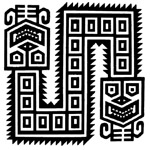Center, Textile Research

PreColumbian Textile Conference VII / Jornadas de Textiles PreColombinos VII (2016)
Date of this Version
11-13-2017
Document Type
Article
Citation
In PreColumbian Textile Conference VII / Jornadas de Textiles PreColombinos VII, ed. Lena Bjerregaard and Ann Peters (Lincoln, NE: Zea Books, 2017), pp. 191–213
doi:10.13014/K2KK98ZG
Abstract
In spring 2014, I took part in an archaeological project carried out by a German-Peruvian team of archeologists in the Sechín Valley, next to the Valley of Casma, on the North Coast of Peru. The project started more than ten years ago and has been taking place parallel to some other important archaeological projects on the North Coast. Its aim was to unearth the temple mounds and to reconstruct the parts of the various phases. The earliest layers date back to the Pre-Ceramic Period. During the wall construction of the temple, many textile fabrics such as nets and ropes were used and some very early textile fabrics were found. The site was abandoned after thousands of years and a cemetery was placed on top of it. The cemetery comes from a later time period and contains tombs from different phases of cultures of the north Coast i.e. Moche and Chimú. My task was to examine these archeological textiles. The aim was to classify the textile objects and create an initial source of data. In this article I will present the textiles of the excavation and some particular examples with their typical characteristics. The textile artifacts were excavated in a small but very concrete area and the fabrics reflect a very long period of time.
Textiles Arqueológicos de Sechín Bajo - Un Sitio Formativo de la Costa Norte del Perú: Resultados Preliminares
Resumen -- En la primavera de 2014, participé en un proyecto arqueológico llevado a cabo en el valle de Sechín, cerca al valle de Casma, en la costa norte del Perú. El proyecto se inició hace más de diez años y se realiza paralelamente a otros proyectos arqueológicos de importancia en la Costa Norte. Su meta ha sido excavar los montículos de templos y reconstruir en parte sus varias fases de construcción. Las capas más tempranas datan al Período Pre-cerámico. Durante la construcción de los muros del templo, varios materiales textiles como redes y sogas fueron utilizados y se encontraron algunos materiales textiles muy tempranos. El sitio fue abandonado después de miles de año de uso y un cementerio se ubicó encima. El cementerio data de un época más tardía y contiene tumbas de diferentes fases culturales de la costa norte, eg. Moche y Chimú. Mi tarea ha sido examinar estos textiles arqueológicos. La meta fue clasificar los objetos textiles y crear una fuente inicial de datos. En este ensayo, se presentan los textiles de la excavación y algunos ejemplos particulares con sus característicos típicos. Los artefactos textiles se excavaron en un área pequeña pero muy concreta, y los materiales reflejan un rango temporal muy largo.
Included in
Art and Materials Conservation Commons, Chicana/o Studies Commons, Fiber, Textile, and Weaving Arts Commons, Indigenous Studies Commons, Latina/o Studies Commons, Museum Studies Commons, Other History of Art, Architecture, and Archaeology Commons, Other Languages, Societies, and Cultures Commons


Comments
Copyright © 2017 by the author.